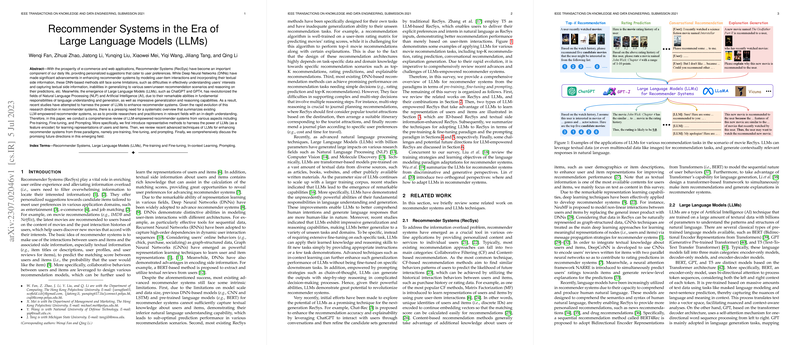Recommender Systems in the Era of LLMs
Introduction
The integration of LLMs into Recommender Systems (RecSys) has garnered significant interest due to the enhanced capabilities that LLMs provide in language understanding, generation, generalization, and reasoning. These models have transformed traditional recommender systems by addressing limitations like understanding user interests, capturing textual side information, and generalizing across various recommendation scenarios.
Pre-training Paradigm for Recommender Systems
Pre-training of LLMs involves training on extensive and diverse datasets to assimilate broad linguistic patterns and structures. For recommender systems, pre-training methods such as Masked LLMing (MLM) and Next Token Prediction (NTP) play pivotal roles:
- PTUM employs tasks like Masked Behavior Prediction (MBP) and Next K Behavior Prediction (NBP) to model user behaviors, showcasing the utility of pre-training in capturing user interactions.
- M6 uses text-infilling objectives and auto-regressive generation to assess text plausibility and predict unmasked sequences, enhancing recommendation accuracy.
- P5 adopts multi-mask modeling for generalized recommendation tasks, leveraging a unified indexing method for pre-training LLMs on various datasets.
These methods underscore the necessity of pre-training in enabling LLMs to process and predict user interactions effectively.
Fine-tuning Paradigm for Recommender Systems
Fine-tuning is essential for adapting pre-trained LLMs to specific recommendation tasks. It is divided into full-model fine-tuning and parameter-efficient fine-tuning:
- Full-model Fine-tuning involves altering the entire model weights. For instance:
- RecLLM fine-tunes LaMDA for YouTube recommendations.
- GIRL uses supervised fine-tuning for job recommendations.
- UniTRec combines discriminative matching scores with candidate text perplexity to boost text-based recommendations.
- Parameter-efficient Fine-tuning (PEFT) fine-tunes only a small subset of model weights, reducing computational costs:
- TallRec and GLRec use Low-Rank Adaptation of LLMs (LoRA) for efficient fine-tuning.
- M6 incorporates LoRA for deploying LLMs on constrained devices.
These strategies highlight the adaptability and efficiency of LLMs when fine-tuned for RecSys.
Prompting LLMs for Recommender Systems
Prompting leverages task-specific prompts to direct LLMs without parameter updates. Techniques include In-context Learning (ICL), Chain-of-Thought (CoT) prompting, and prompt tuning:
- In-context Learning (ICL):
- Few-shot ICL uses input-output examples to guide LLMs in recommendation tasks.
- Zero-shot ICL employs task descriptions for improvisational adaptation.
- Chain-of-Thought (CoT) Prompting enhances reasoning by breaking down tasks into intermediate steps.
- Prompt Tuning:
- Hard Prompt Tuning can be seen in ICL settings where discrete text templates guide the model.
- Soft Prompt Tuning uses continuous vectors optimized via gradient updates, providing a balance between efficiency and explainability.
These methods improve the recommendation performance of LLMs by making effective use of prompts and contextual data.
Future Directions
Looking forward, several key areas need exploration:
- Hallucination Mitigation: Addressing erroneous outputs through integration of factual knowledge and verification mechanisms.
- Trustworthy LLMs for RecSys: Ensuring safety, robustness, fairness, explainability, and privacy in LLM-driven recommendations.
- Vertical Domain-Specific LLMs: Developing domain-specific models for targeted and high-quality recommendations.
- Users{content}Items Indexing: Employing advanced indexing methods to capture interactions more effectively.
- Fine-tuning Efficiency: Enhancing efficiency through strategies like adapter modules and LoRA.
- Data Augmentation: Utilizing LLMs to simulate and create diverse training datasets for improved robustness.
Conclusion
This survey provides an in-depth exploration of the integration of LLMs into recommender systems, covering pre-training, fine-tuning, and prompting paradigms. As research progresses, systematic and comprehensive approaches are necessary to address current limitations and unlock the full potential of LLMs in recommender systems. The future developments highlighted here will contribute to the evolution of more sophisticated, reliable, and efficient recommendation technologies.
